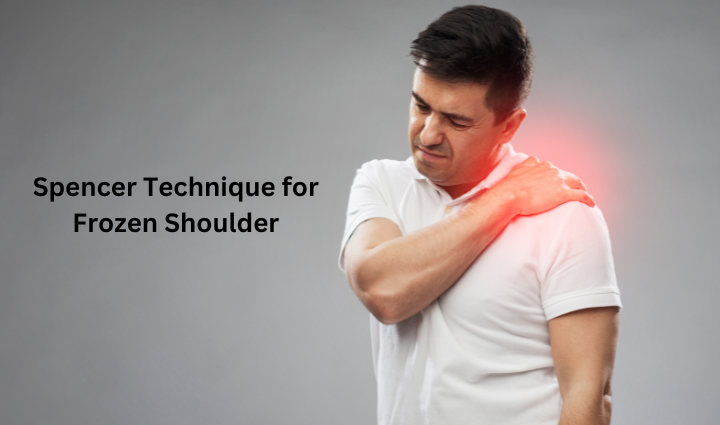Indication:
Adhesive capsulitis, commonly known as frozen shoulder, can benefit from the Spencer technique. This approach helps alleviate pain, enhance the range of motion in the shoulder, and reduce functional limitations for individuals experiencing this condition.
Clinical Application:
Spencer noted that while applying this treatment, moderate pain is almost inevitable, though it should not be severe. He emphasized that progress is gradual, focusing on stretching rather than causing any tearing.
Characteristics:
Shoulder Girdle:
The Spencer technique involves seven stages designed to address somatic dysfunctions of the shoulder girdle, which comprises the clavicle, scapula, humerus, and their respective joints. Although the technique primarily targets the glenohumeral joint, it can also be applied to dysfunctions of the clavicle and scapula. It is frequently used for treating shoulder issues related to adhesive capsulitis, commonly known as frozen shoulder.
Articulatory Technique:
The seven stages of the Spencer technique are classified as articulatory methods. These techniques involve moving the affected joint through its complete range of motion with low velocity and moderate
to-high amplitude. Articulatory techniques are direct, addressing the dysfunction by moving it into the restrictive barrier, and passive, with the practitioner applying the necessary forces for treatment.
Muscle Energy Activation:
Muscle energy techniques can complement the seven stages of Spencer. In this approach, the practitioner first moves the patient passively to the restrictive barrier. The patient is then guided to actively move the joint in the opposite direction of the barrier while the practitioner provides resistance. After a few seconds, the patient relaxes, and the practitioner then gently advances the joint to the next restrictive barrier.
Stages:
Extension:
In Stage 1 of the seven stages of Spencer, the focus is on glenohumeral extension with the elbow flexed. The patient lies on their side with the shoulder being treated elevated. The practitioner positions themselves in front of the patient, placing one hand on the shoulder joint’s upper part and the other hand grasping the flexed elbow. The arm is then moved backward to extend the shoulder. When reaching the restrictive barrier, the practitioner may apply a springing or oscillatory motion. Additionally, muscle energy techniques can be used to further enhance this treatment.
Flexion:
In Stage 2 of the seven stages of Spencer, the focus is on glenohumeral flexion with the elbow extended. The practitioner holds the top of the shoulder joint with one hand and the patient’s hand with the other. The arm, with the elbow extended, is then moved forward to flex the shoulder. As with the previous stage, treatment is applied at the restrictive barrier as described.
Circumduction with Compression:
In Stage 3, the procedure involves circumduction with gentle compression while the elbow remains flexed. The patient starts by flexing their elbow, and the arm is then abducted until it reaches the point of resistance. The practitioner applies light compression through the elbow to the shoulder joint. During this process, the practitioner moves the elbow in small, concentric circles, gradually increasing the size of the circles.
Circumduction with Traction:
In Stage 4, the technique involves circumduction with gentle traction while the elbow is extended. Similar to Stage 3, the arm is abducted to the point of resistance. However, in this stage, the elbow is fully extended. The practitioner holds the wrist and applies a gentle upward traction. The arm is then
moved in concentric circles, beginning with small circles and progressively increasing in size, which facilitates circumduction at the shoulder joint.
Abduction then Adduction with External Rotation:
Stage 5 consists of two distinct parts:
Stage 5a: Abduction with the Elbow Flexed:
In this part, the practitioner uses their most superior arm to hold the patient’s shoulder. The patient then grabs this arm with the arm being treated. The practitioner proceeds to move the shoulder into abduction, leveraging the elbow to facilitate the movement.
Stage 5b: Adduction with External Rotation:
For this stage, the setup is similar to Stage 5a, but the patient places their wrist on the practitioner’s arm. The practitioner then moves the elbow downward towards the table, which results in adduction and external rotation at the shoulder joint.
Internal Rotation:
Stage 6 involves internal rotation of the shoulder. In this stage, the patient’s arm is positioned at approximately 45 degrees of abduction, with the back of the hand resting on the lower back. The elbow is then gently moved forward, which facilitates internal rotation of the shoulder joint.
Distraction:
Stage 7 involves a technique known as distraction or distraction in abduction. During this stage, the practitioner positions the patient’s arm over their own shoulder. They then use both hands to grasp the shoulder just below the acromioclavicular joint. By applying a downward, scooping motion to the upper arm, the practitioner creates a separation at the glenohumeral joint, known as distraction.




